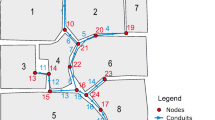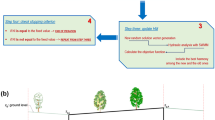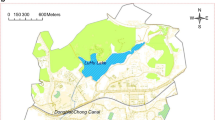Abstract
The present paper describes a framework for the evaluation of a drainage system’s capacity in order to get a better understanding of the interactions between three rehabilitation measures: the Upgrading of Pipes (UP), Distributed Storage (DS) and the combination of both (UP+DS). It is posed as a multi-objective optimisation problem with the aim of minimising rehabilitation costs and flood damage. The approach of Expected Annual Damage Cost (EADC) was also introduced as the probabilistic cost caused by floods for a number of probable flood events (i.e. the accumulation of damage during a timeframe). The study combines computational tools such as a 1D/2D flood inundation model and an optimisation engine in the loop to compute potential damages for different rainfall events and to optimise combinations of rehabilitation measures. The advantages of this approach are demonstrated on a real-life case study in Dhaka City, Bangladesh. The optimal solutions confirm the usefulness and effectiveness of the proposed approach where both rehabilitation and damage costs are reduced by the optimal implementation of the UP and DS measures. In addition, the results of the proposed EADC approach indicate a damage cost reduction of at least 56% by implementing UP and of 27% by implementing DS, and both measures have lower rehabilitation costs. The proposed approach can be found appealing to water/wastewater utilities who are often challenged to achieve optimal design and rehabilitation of urban drainage systems.







Similar content being viewed by others
References
Abdullah AF, Vojinovic Z, Price RK, Rahman AA (2009) Lidar Filtering Algorithms and DTM Generation for Urban Flood Modelling Applications: Review of Current Algorithms and Filters Test, 8th International Conference on Urban Drainage Modelling, Tokyo, Japan, 7-11 September
Ahmed F (2008) Urban flood, its effects and management options: a case study of Dhaka City. UNESCO-IHE Institute for Water Education, Delft
Artita KS, Kaini P, Nicklow J (2013) Examining the possibilities: generating alternative watershed-scale BMP designs with evolutionary algorithms. Water Resour Manag 27(11):3849–3863 doi.org/10.1007/s11269-013-0375-3
Barreto W (2012) Multi-objective optimization for urban drainage rehabilitation CRC Press/Balkema ISBN 978-0-415-62478-7 Taylor & Francis group
Cunha M, Zeferino J, Smiles N, Saldarriaga J (2016) Optimal location and sizing of storage units in a drainage system. Environ Model Softw 83:155–166 doi.org/10.1016/j.envsoft.2016.05.015
Deb K, Pratap A, Agarwall A, Meyarivan T (2002) A fast and elitist multi-objective genetic algorithm. IEEE Trans Evol Comput 6(2):182–197
Diao K, Sweetapple C, Farmani R, Fu G, Ward S (2016) Global resilience analysis of water distribution systems. Water Res J 106:383–393. https://doi.org/10.1016/j.watres.2016.10.011
Dominguez D, Truffer B, Willi G (2011) Tackling uncertainties in infrastructure sectors through strategic planning: the contribution of discursive approaches in the urban water sector. Water Policy J 13(3):299–316. https://doi.org/10.2166/wp.2010.109
Duan H, Li F, Yan H (2016) Multi-objective optimal design of detention tanks in the urban stormwater drainage system: LID implementation and analysis. Water Resour Manag 30:4635–4648. https://doi.org/10.1007/s11269-016-1444-1
Dutta D, Herath S, Musiake K (2001) Direct flood damage modeling towards urban flood risk management. International Center for Urban Safety Engineering (ICUS/INCEDE), IIS, The University of Tokyo, Japan, p 128–143
DWASA (2015) Dhaka water supply and sewerage authority. Stormwater drainage master plan for Dhaka City. Financial and economic analysis. Final Report August 2015.JPZ-FCEA-SARM-JV
Islam K (2005) Flood loss potentials in non-agricultural sectors, assessment methods and standard loss database for Bangladesh. Palak Publishers, Dhaka
Krebs P, Larsen TA (1997) Guiding the development of urban drainage systems by sustainability criteria. Water Sci Technol 35(9):89–98 http://wst.iwaponline.com/content/35/9/89
Marques J, Cunha M, Savic D (2015) Multi-objective optimization of water distribution systems based on a real options approach. Environ Model Softw 63:1–13. https://doi.org/10.1016/j.envsoft.2014.09.014
Martínez C, Beheshtah T, Sanchez A, Vojinović Z (2014) Flood resilience assessment in urban drainage systems through multi-objective optimisation. International Conference on Hydroinformatics 2014, New York, 17-21. CUNY Academic Works. http://academicworks.cuny.edu/cc_conf_hic/236
Mugume S, Gomez D, Guangtao F, Farmani R, Butler D (2015) A global analysis approach for investigating structural resilience in urban drainage systems. Water Res J 81:15–26. https://doi.org/10.1016/j.watres.2015.05.030
Olsen A, Zhou Q, Jorgen J (2015) Comparing methods of calculating expected annual damage in urban pluvial flood risks assessments. Water 7:255–270. https://doi.org/10.3390/w7010255
Park M, Chung G, Yoo C, Kim JH (2012) Optimal design of stormwater detention basin using the genetic algorithm. KSCE J Civ Eng 16(4):660–666. https://doi.org/10.1007/s12205-012-0991-0
Rossman L (2010) Storm water management model - user’s manual version 5.0. Cincinnati Ohio
Sanchez A, Medina N, Vojinovic Z, Price R (2014) An integrated cellular automata evolutionary-based approach for evaluating future scenarios and the expansion of urban drainage networks. J Hydroinf 16(2):319–340. https://doi.org/10.2166/hydro.2013.302
Schellekens E, Ballard D (2015) Resilience pathway 2.0; a promising pathway for cities to accelerate climate adaptation while unlocking private money flows and raising capacity levels. In: Amsterdam International Water Week proceedings 2-6 November
Seyoum S, Vojinovic Z, Price R, Weesakul S (2012) A coupled 1D and non-inertia 2D flood inundation model for simulation of urban flooding. ASCE J Hydraulic Eng 138(1):23–34. https://doi.org/10.1061/(ASCE)HY.1943-7900.0000485
Ten Veldhuis J, Clemens F (2011) The efficiency of asset management strategies to reduce urban flood risk. Water Sci Technol J 64(6):1317–1324. https://doi.org/10.2166/wst.2011.715
Vojinovic Z, Solomatine D, Price R (2006) Dynamic least-cost optimisation of wastewater system remedial works requirements. Water Sci Technol 54(6-7):467–475 IWA Publishing
Vojinovic Z, Bonillo B, Chitranjan, K, Price R (2006a) Modelling flow transitions at street junctions with 1D and 2D models, 7th International Conference on Hydroinformatics, Acropolis - Nice, France, September
Vojinovic Z, Sahlu S, Sanchez A, Seyoum S, Anvarifar F, Matungulu H, Barreto W, Savic D, Kapelan Z (2014) Multi-objective rehabilitation of urban drainage systems under uncertainties. J Hydroinf 16(5):1044–1061. https://doi.org/10.2166/hydro.2014.223
Yazdani A, Appiah O, Jeffrey P (2011) Resilience enhancing expansion strategies for water distribution systems. A network theory approach. Environ Model Softw 26(12):1574–1582. https://doi.org/10.1016/j.envsoft.2011.07.016
Yazdi J, Lee EH, Kim JH (2014) Stochastic multiobjective optimization model for urban drainage network rehabilitation. J Water Resour Plan Manag. https://doi.org/10.1061/(ASCE)WR.1943-5452.0000491
Zhou Q, Panduro T, Thorsen J, Arnbjerg-Nielsen K (2013) Adaptation to extreme rainfall with open urban drainage system: an integrated hydrological cost-benefits analysis. Environ Manag J 51(3):586. https://doi.org/10.1007/s00267-012-0010-8
Author information
Authors and Affiliations
Corresponding author
Rights and permissions
About this article
Cite this article
Martínez, C., Sanchez, A., Toloh, B. et al. Multi-objective Evaluation of Urban Drainage Networks Using a 1D/2D Flood Inundation Model. Water Resour Manage 32, 4329–4343 (2018). https://doi.org/10.1007/s11269-018-2054-x
Received:
Accepted:
Published:
Issue Date:
DOI: https://doi.org/10.1007/s11269-018-2054-x




